Mephedrone (4-methylmethcathinone) is a synthetic cathinone, a class of psychoactive substances derived from the naturally occurring stimulant cathinone found in the khat plant (Catha edulis). 4mmc is a substance of abuse (mephedrone abuse). Since its emergence in the early 2000s, mephedrone has gained popularity as a recreational drug due to its stimulant and empathogenic effects, which are often compared to those of mephedrone and MDMA (3,4-methylenedioxymethamphetamine). However, the use of mephedrone has been associated with various adverse effects, including serotonin syndrome, a potentially life-threatening condition resulting from increased serotonergic activity in the central nervous system (CNS).
Its action is based on increasing the concentration of catecholamines and monoamines in the nervous system. It increases the activity of the proteins that transport serotonin, dopamine and norepinephrine from the neurons into the synaptic clefts.
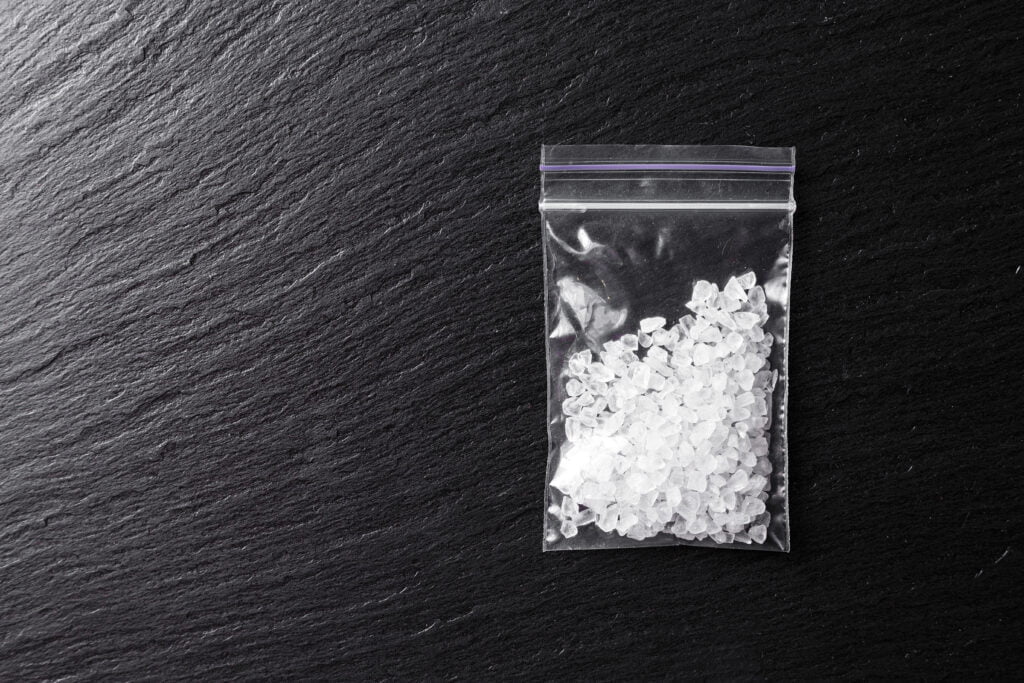
In addition, 4mmc inhibits the reuptake of these substances and reduces the activity of the enzymes that break them down. The amount of norepinephrine, which is responsible for mental and physical activity, increases dramatically. The content of serotonin and dopamine increases, providing euphoria, increased mood and a desire to communicate.
There are many ways to use mephedrone: orally, intranasally, intravenously, rectally. The probability of overdose and lethal outcome increases with intravenous injection of the drug solution, as in this case a large amount of the substance enters the bloodstream at one time.
Ways of using mephedrone
Every recreational user faces the problem of individualizing the dosage of mephedrone. In most cases, the use of cathinones is carried out by imprecise calculation of the dose by the length of the “track” of crystals, without taking into account a large number of nuances (purity of the product, presence of tolerance, method of use, combination of mephedrone with other psychoactive substances, presence of diseases and so on).
Undoubtedly, 4-mmc is harmful to health and the use of this substance is associated with high risks, but if used competently, it is possible to minimize the risks and reduce the likelihood of side effects. Mephedrone can be consumed in a variety of ways: “bombs” in the form of gelatin capsules, pressed tablets, white powder (crystals), mephedrone hydrochloride solution (parenterally), smoking mephedrone crystals (ineffective and dangerous) and using a rectal suppository (dangerous).

Mephedrone starts to take effect almost immediately, the effect lasts from 30 minutes to 2 hours depending on the dose. When injected intravenously, the user feels the strongest euphoria, called “high”. In other ways of use, the drug has a milder effect.
Who’s at risk?
Young people are particularly at risk, as the drug is often sold in nightclubs and is often used by students to prepare for exams. Based on a study published in the Journal of Epidemiology and Community Health, adolescents who regularly used marijuana from the age of 13-18 started smoking cigarettes, drinking alcohol, and using other drugs more often compared to adolescents who did not. In addition, based on a study conducted in Norway, England, and Russia, mephedrone addicts are generally people who are not marginalized, so just about anyone can be at risk.
Also at risk are people whose jobs require a lot of waking hours (drivers, construction workers) and those whose occupation requires them to keep themselves in a certain physical shape: athletes, models, and so on.

Mechanism of action of mephedrone
Once in the human body, mephedrone releases neurotransmitters: dopamine, noradrelin, and serotonin, but less than with MDMA. It acts on both the central and peripheral nervous system.
Central nervous system effects include euphoria, increased concentration, self-confidence, and wordiness. Negative effects may include anxiety, paranoia, delirium and panic attacks.
Effects on the peripheral nervous system: dilated pupils, effects on the cardiovascular system (tachycardia, increased blood pressure), seizures, dry mouth, hyperthermia or chills. When the effects of the drug wear off, the person feels exhausted, lethargic and irritable.
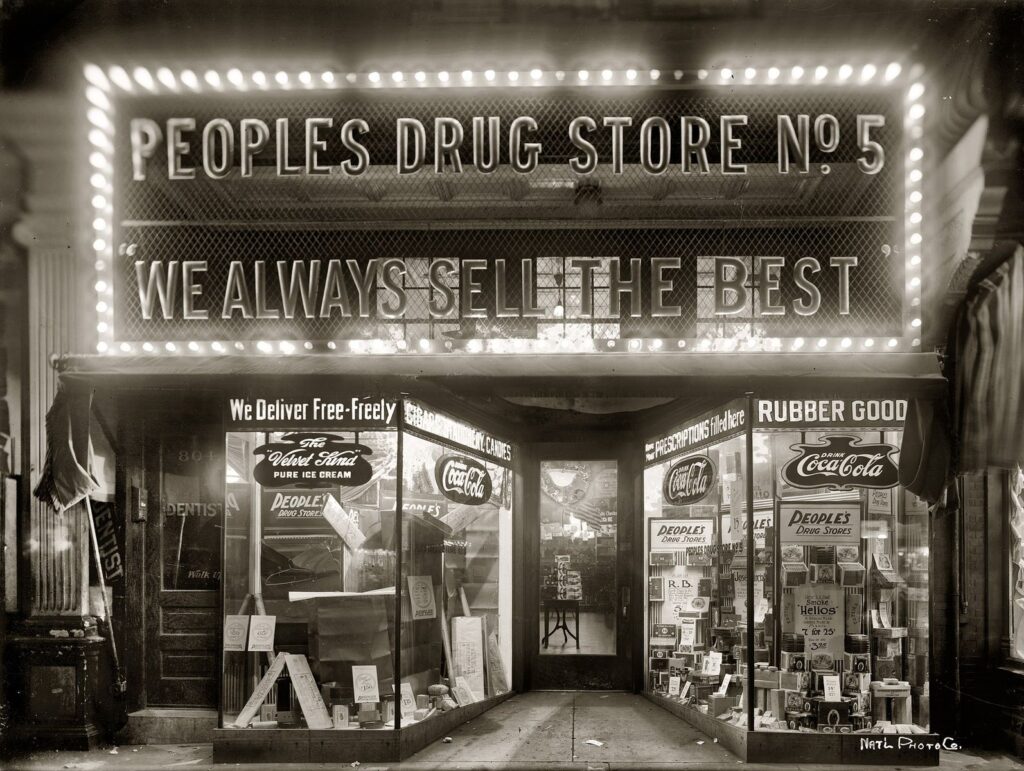
How to identify a mephedrone addict
In order to understand if a person is using mephedrone, it is necessary to know several factors about its effects on the body. The simplest sign is dilated pupils, pallor, possible redness in the upper body, excessive talkativeness, lip nibbling, and involuntary jaw movements.
With long-term use, a mephedrone addict is likely to exhibit symptoms such as: dental problems, bad skin, and drastic weight loss. With regular use, people close to the addict may notice changes in behavior. The person may experience hysterics, paranoia, hallucinations and reduced concentration.
Mephedrone abuse and addiction
Mephedrone is considered to be a narcotic drug with moderate narcogenic potential. People who use it occasionally and in minimal doses do not develop dependence. But if the drug is taken more often than once in 7-10 days and neglect the dosage, then after 2-4 weeks there will be an extremely strong psychological craving for repeated use. Each time the post-intoxication state becomes more and more severe, and in a few months a withdrawal syndrome is formed, indicating the presence of physical dependence on mephedrone. Experience with other psychostimulants, mixing the drug with alcohol and narcotic substances, and intravenous injection of mephedrone solution also contribute to the formation of drug addiction.
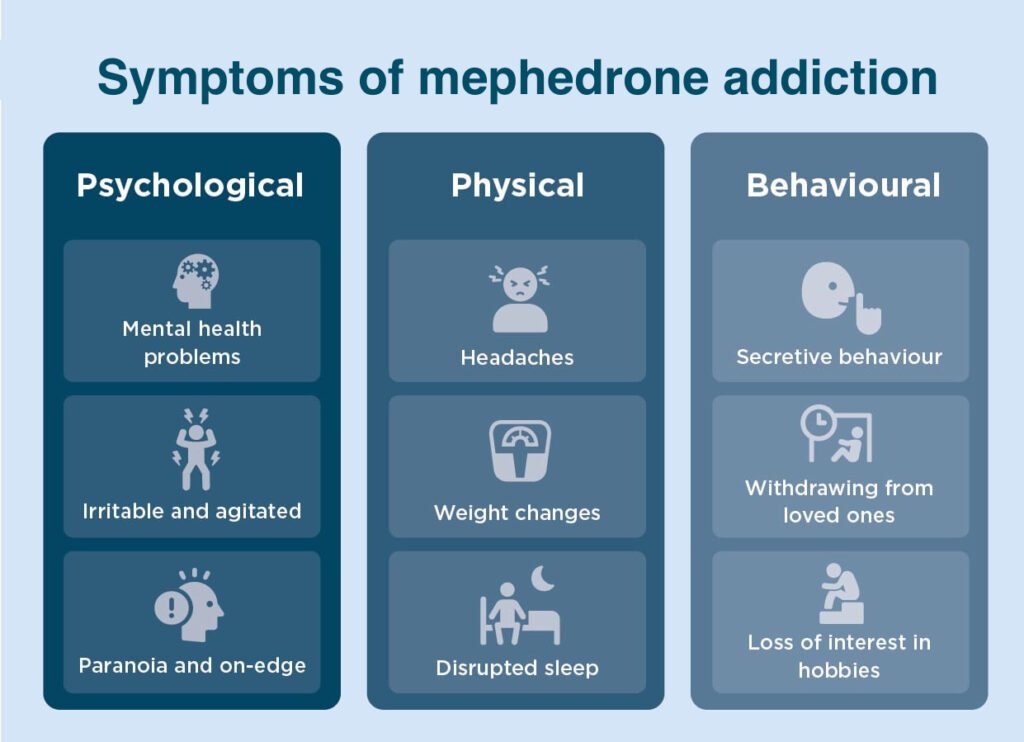
Psychological cravings for mephedrone
With regular use, mephedrone causes an extremely strong psychic dependence. At the physiological level, its formation is explained by the fact that the drug increases the activity of dopamine in the brain centers responsible for the sensation of pleasure and the development of reward system reactions. This system controls behavior through the perception and “memory” of positive states arising in response to any action. In this way, behavior is formed, aimed at finding and using mephedrone, because its entry into the body creates a positive state – euphoria, high performance, sociability. At the psychological level, addiction is manifested by a person’s desire to experience mephedrone “intoxication” again and again.
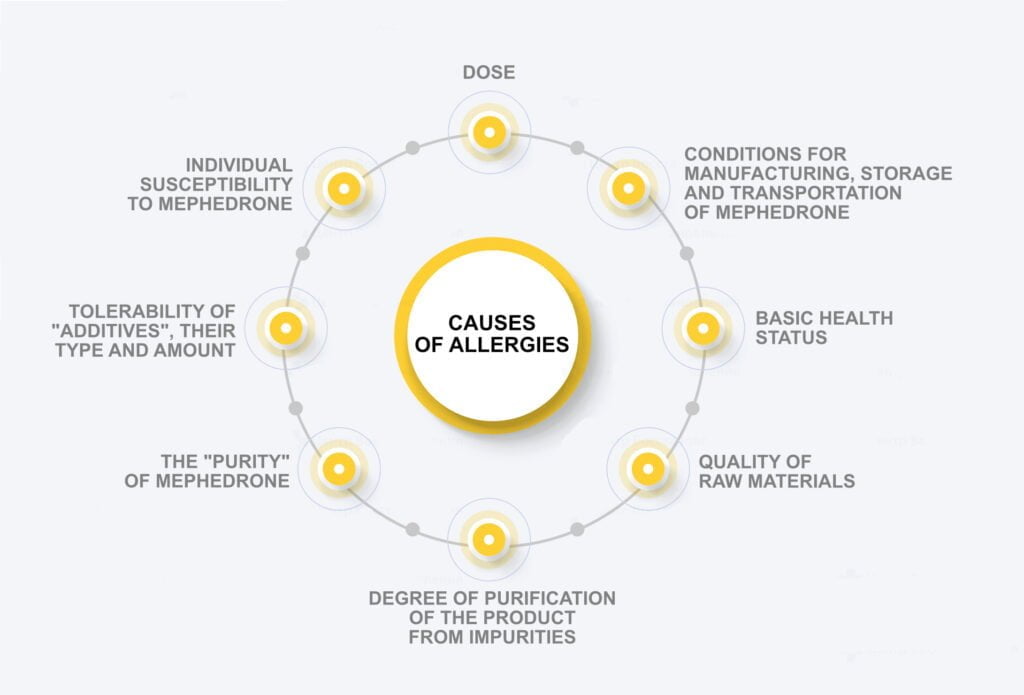
Mephedrone overdose
Mephedrone overdose can occur from different doses of the drug depending on the method of use, continued use, purity of the substance and the general state of the human body. For example, in the absence of addiction, the dose that causes an overdose is 10-30 mg when administered intravenously, while mcat addicts may not overdose even at 1000 mg per day. The lethal dose is 20/40 mg per 1 kg of body weight.
The main signs of 4-MMC overdose from the side of behavior: restlessness, delirium, panic attack, speech excitement, abruptly replaced by apathy, anxiety, disorientation, hallucinations, paranoia.
Body: headache, dizziness, palpitations, stabbing and pressing pain in the heart area, chest, a feeling of shortness of breath, shortness of breath, dyspnea, nausea, vomiting, diarrhea, fever, increased sweating, erythematous skin rashes, a feeling of shortness of breath, nausea, vomiting, diarrhea, increased sweating, difficulty urinating, dilated pupils, seizures.

Psychotherapy and support groups for adolescent mephedrone users
One of the main goals of mephedrone addiction treatment is to change the mindset and lifestyle of the patient, to create conditions that will help them to refuse to use the drug, even if it is available. Effective ways to achieve this are psychotherapy sessions and support group meetings – people who are also struggling with addiction and can share their experiences with each other. Among the non-medication methods of treatment, the following are widespread:
- Cognitive behavioral therapy. A psychotherapist helps patients learn to recognize and avoid situations that increase the risk of mephedrone use. Self-control and stress coping skills are learned. Under the influence of psychotherapy there is a change in lifestyle: a new system of relationships and values is created, the number of hobbies not related to drugs increases.
- Group therapy. Working in a group allows the patient to feel social support, to understand how his actions and thoughts are evaluated by other people. It has been found that the opinion of other addicts is often more valuable than that of the therapist. Therefore, the ideas expressed by the group members are more motivating for changes in life and abstinence from drugs.
- Family therapy. The patient’s family members and close friends create a system of relationships that either supports the addiction or helps to fight it. Psychotherapeutic work helps relatives understand the mechanisms of drug addiction and change daily life so that the patient’s craving for mephedrone is reduced.
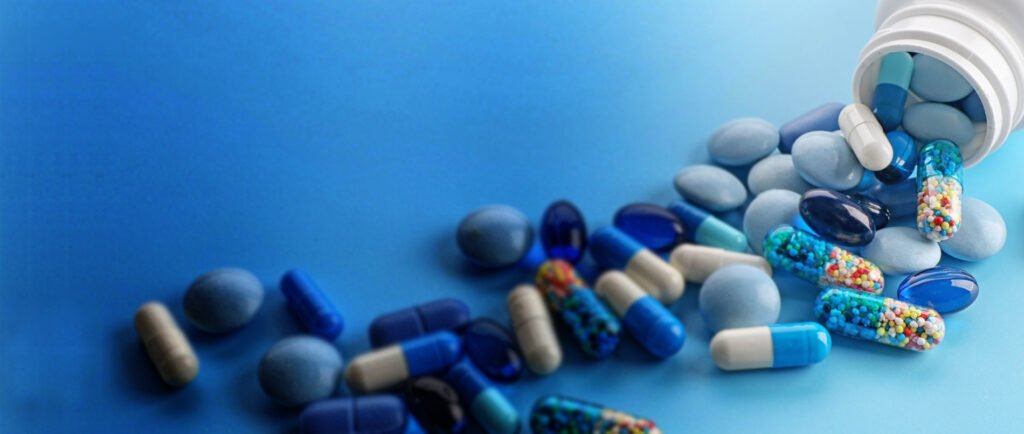
Rehabilitation after mephedrone use
Rehabilitation activities are aimed at helping the patient return to social life and avoid relapse into drug use. They can be conducted on an outpatient basis, for example, as part of meetings at drug treatment centers, or with the patient living in a specially organized place – village, commune, camp. During rehabilitation programs, people live in conditions where taking drugs is impossible. Former drug addicts share their experience, discuss emotional problems, and learn from each other’s mistakes. Labor adaptation is carried out within the framework of joint everyday life, learning new professions. Much attention is paid to proper nutrition, regular physical activity, and following regimen procedures.
